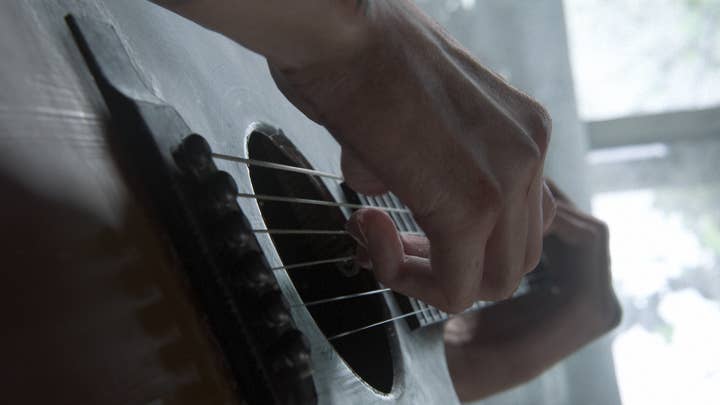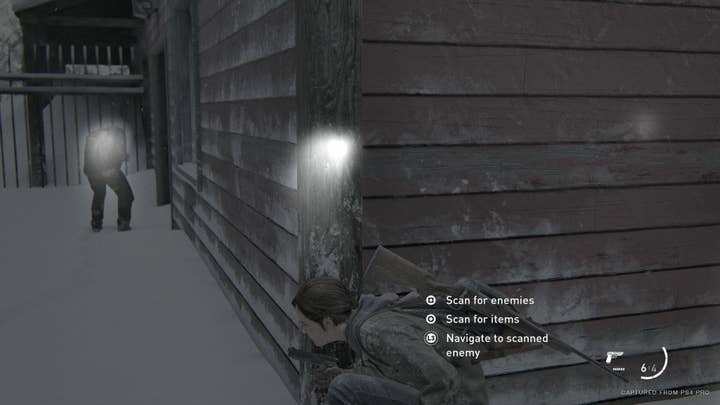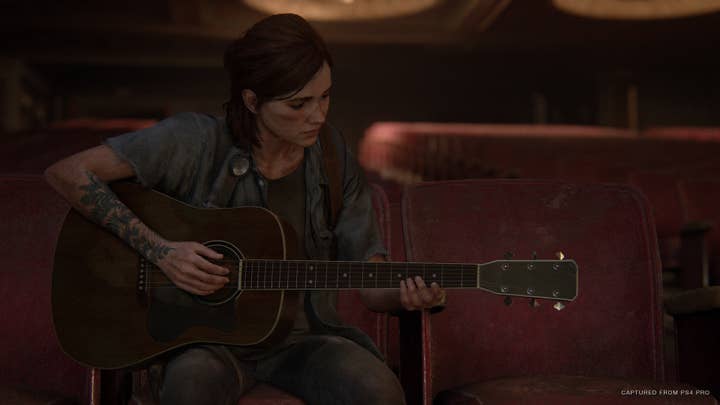How audio brought The Last Of Us: Part 2 to life
Naughty Dog's Rob Krekel shares the secrets behind The Last of Us: Part 2's award-winning audio
There can't be much space left in the awards cabinet at Naughty Dog HQ, especially with The Last of Us: Part 2 still sweeping up at ceremonies.
Alongside numerous game of the year awards, most notably a BAFTA, TLOU: Part 2 took home eight of the 30 available accolades -- more than any other title -- at the recent Game Audio Network Guild Awards, with standout achievements including audio of the year, creative and technical achievement in sound design and excellence in audio accessibility.
It's not often that video games get such widespread praise for their audio. The irony of game audio is that when audio teams are doing their jobs correctly, players shouldn't be able to notice. But TLOU: Part 2 has been recognised as a masterclass in audio design where the emotional and psychological impact of sound (or lack of) has been carefully considered at every stage of development.
Audio has been an integral part of the TLOU experience since the release of the first title on the PS3 in 2013. Both titles are an amalgamation of stealth, survival horror and action segments, but you'll spend most of your time creeping around the eerie and often-silent post-apocalyptic ruins of America as Joel and Ellie praying you don't make a sound. In TLOU, your own sounds are often your worst enemy.

Savouring the sound of silence
"For the Last of Us Part 1, the biggest thing that we learned was the audience's tolerance for silence and the dynamic range of our soundscapes," Rob Krekel, audio director at Naughty Dog who worked on both TLOU titles tells us.
"Video games are often trying to scream at you and point out the things that are most important and critical to gameplay. We found that given the world and the narrative [in The Last of Us] -- which is always what we're trying to support -- there was an awesome opportunity to push [the sound] down, which is rare. We relish the quiet and silent moments that both games afforded us and learned quite a lot about what the audience would tolerate as a result of [Part 1], which meant we really went for it in the second game."
Setting so many of the game's organic sounds against a backdrop of silence makes them all the more brutal when you do hear them, whether that's the clang of a crowbar cracking human bones or your enemy's blood-curdling screams ringing down the hollow halls of an abandoned hospital. It all feels very real, and you'll often experience moments of guilt as you steer Ellie through her vengeance-fuelled bloodlust.

"Another part of our goal is making enemies feel realistic so it supports the story and the psyche that Ellie is going through," Krekel says, highlighting the importance of the game's "unsung hero" -- an AI-driven dialogue system where enemies communicate in impressive detail, calling their friends by first names or speaking about specific locations to search. All of this adds to the sense of realism and heightens the emotional weight when it comes to taking down human enemies.
"When you take somebody down, they're going to be choking on their own blood and it's going to be super uncomfortable, and we did that on purpose," Krekel continues. "We want people to think, 'Oh no, I really wish I didn't have to do that.' If that's the reaction that people are getting, ultimately we did our jobs right."
Silence has another important role in Part 2: creating dramatic tension. In moments where silence reigns, such as the cliffhanger ending in Part 1, it's all about what characters choose not to say. Krekel tells us No Country for Old Men and The Revenant were two films that contained a lot of great reference material for using sound in an organic and psychological way.
"But we also referenced our own games a lot too," he says "When we were working on Part 2, it was really critical that we kept moving forward with the aesthetic that we established in Part 1. I was not interested in reinventing the wheel. Part 2 is the culmination of a lot of the ideas that we started in Part 1 where we had certain technological, time and physics limits, and for Part 2 we were able to take a lot of those ideas to their logical conclusions."
Using 3D audio for accessibility
3D audio is a feature that Mark Cerny, lead architect on the PS4 and PS5, described as setting a new gold standard for game audio in advance of the PS5's launch, but a handful of titles on the PS4 do support it through the PlayStation Platinum headset. If you want to experience Part 2 at its best through the elevation, direction and distance of sound sources, make sure you don't play through without a pair. Naughty Dog was an early adopter of 3D audio, Krekel tells us, with the team first implementing it for Uncharted 4.
"We've always thought three-dimensionally about audio, back from basically the Jak and Daxter era," he says. "When Bruce Swanson was the audio director here, it was always the ethos and the goal to author sounds in a way that makes sense in three dimensions, even though we can't represent that with two speakers and headphones or off a TV, or even in 5.1, that was always the goal. The beauty of thinking about 3D audio for so long is that we get to take advantage of this new technology and it becomes more accurate and more immersive for the players."
The focus on 3D audio in The Last of Us: Part 2 means it's possible for players to navigate the world largely by sound, thanks to the massive selection of audio cues and supported features that can be toggled in the game's accessibility menu.
"3D audio [augments] all of the accessibility sounds that are represented in the game"
"I've actually watched a blind player play through The Last of Us: Part 2 all the way from start to finish, and major credit to our sound designer, Justin Mullens, who developed and worked with our design team to develop a lot of the audio cues that are specific to blind accessibility," says Krekel.
3D audio also allowed Naughty Dog and Part 2's accessibility consultant, Brandon Cole, to further develop the game's listen mode introduced in Part 1 -- an important gameplay feature that lets players reveal enemy locations through walls and other environments by sending out a sonar ping.
"Having that elevation when you have one of those sonar pings so you can actually tell who is above you or below you, in addition to designing the sounds with different pitch ranges so that it adds even more information to the people who have sight issues is incredibly important," says Krekel. "Getting that information to blind players has been game-changing, and an extremely helpful way for them to understand things that are above them and around them. 3D audio [augments] all of the accessibility sounds that are represented in the game."

Tactical sounds and foley
While some of the sounds in Part 2 are from sound libraries, many of the ones that you might take for granted -- the sound of footsteps, various articles of clothing, guns and every click associated with them -- were recorded from scratch. Even the rain used in Part 2 was recorded in the Pacific Northwest for added authenticity.
Rain might sound like an easy thing to implement into a game, but as Krekel explains, it makes different sounds depending on the surface area it hits, whether that's bouncing off the trunk of a car, splashing against a bush, landing in a puddle, or dripping down a gutter. All of these effects were individually recorded and worked into the game, with the implementation of 3D audio allowing players to feel like they're fully immersed in the environments they're navigating.
"We try to stick as much detail around the player that will move past them and create something interesting," Krekel says. "Foley is mega important to Naughty Dog games, and when I speak about foley, I specifically mean player-based sounds such as footsteps, cloth, backpacks, weapon movement and all that stuff. We get hyper-specific with what we do.
"Making sure we got the right kind of floppy rubber footsteps is critical to just making things sound so right that the player doesn't question it"
"Depending on your clothing type, you're going to get different sounds, and there's a lot of costume changes that go on throughout the game. We worked really close with our character team to understand what those are. Ellie's Chuck Taylors are an iconic piece of her regalia, and making sure we got the right kind of floppy rubber footsteps to layer in with her movements is critical to just making things sound so right that the player doesn't question it."
The sound of glass crushing beneath your feet is another common audio occurrence in Part 2, and the game's sound designer, Jesse James Garcia, built an entire sound system for breaking glass which he details in a Twitter thread, Garcia calls sound systems such as these 'sonic consequences.' Step quietly, or you'll give away your location to the game's blind enemies, clickers. The sound of your footsteps is so important, in fact, there's an entire physics system built around it.
"That's where the foley system really comes into that," Krekel continues. "We'll spawn decals of tiny glass particles that give you a satisfying crunch sound, and that will happen dynamically no matter where you're smashing glass."
Often, audio designers work around the animations they're provided, but a reverse approach was taken for the workbenches in Part 2, where players spend time upgrading their stats and weapons. A lot of the sounds you hear during these segments are from the dismantling and configuration of real-life guns -- recorded by Krekel himself, a self-confessed "gun-guy," who worked closely with the system's animator to ensure the animations were accurate in terms of the weapons' functions.
"It helps me because then I can use the sounds as they are, rather than trying to cut and manipulate them to fit an animation that isn't quite right. In this case, it was the sound that influenced the animation, which is very rare, but very cool when it actually gets to happen. Making all of this super tactile was really important because players spend a decent amount of time spending their valuable resources on parts and you want them to feel like it really felt good."

Storytelling through sound
As mentioned, audio is implemented to support the narrative and world of the game it serves, and the guitar is used as a form of musical storytelling to support key narrative themes throughout Part 2. If a picture is worth 1,000 words, music may as well be worth 10,000, especially in the case of Pearl Jam's Future Days, the first track we see Ellie play on the guitar -- one which signifies her relationship with Joel and her journey through the various stages of grief after she loses him.
"The guitars play a huge role in Ellie's emotional journey, and the main song that [Ellie] plays is a major part of her emotional state," Krekel says.
Future Days is also the last song that you see her play, or at least try to, in the final moments of the game. At the end of her journey, battered, bruised and with a couple of fingers missing as a result of her rampage, Ellie can no longer play it; her ties with Joel have been cut, she's accepted his loss and she can finally move forward.
Ellie's post-traumatic stress disorder is another major focus in Part 2. It starts after she's separated from Joel in the first title and places her trust in a man named David, who saves her from a gang of infected enemies but later imprisons her. She is eventually rescued by Joel, but things get a lot worse five years later in Part 2 when she loses him.
"Something I advocate any studio to do is listen to your audio folks and make sure you bring them in early to the game's development"
"There's a lot of sounds that are more subjective and are feeding into her PTSD as [Ellie] goes through this traumatic experience, specifically the ear ringing she gets and the sensation of not being able to hear properly when traumatic events happen," Krekel explains. "That ear ringing -- the sort of filtering, slightly fazy, uncomfortable sound, is repeated multiple times throughout the game during these traumatic events.
"And I'll let you in on a secret to that stuff. There's an element to those sounds that is pulled directly from the first game. Ellie's first moment of trauma is when she kills David with the machete and immediately after that you are shifted forward to a scene where she's staring at a deer on a highway. She's in her head and there's this low, rumbling wind -- that wind is the basis for the rest of her PTSD in Part 2 because that's the start of it. I wanted very specifically to connect to that, as this evolution of her mental state going haywire as she reaches the climax of her story."
Throughout Ellie's journey, this evolution of her mental state is also supported by the way music builds in the game, departing from minimalist and melodic stringed passages to music that's more action-focussed, especially during the game's later moments on the Island. The game's main motif composed by Gustavo Santaolalla is played on a ronroco, a South American stringed instrument similar to a banjo. Variations of this motif are interspersed between moments of silence throughout the game to communicate emotion. Characters don't need to speak in order for you to understand them; the music speaks for them and is a testament to the less-is-more approach that's at the heart of The Last of Us.
As Part 2 demonstrates, recognising the role of audio within the player experience from the start of development can have major benefits for both world-building and storytelling.
"Something I advocate any studio to do is listen to your audio folks and make sure you bring them in early to the game's development because [game audio] has some of the hardest working people that I know in the industry," Krekel says.
"What we bring to the table can fundamentally change how the player experiences the game, so it's super important to bring us in early and keep us tight."

